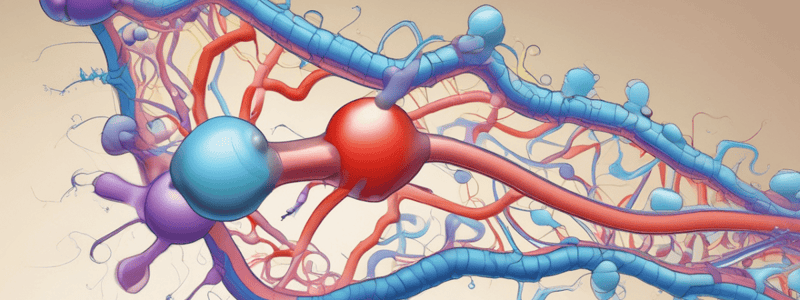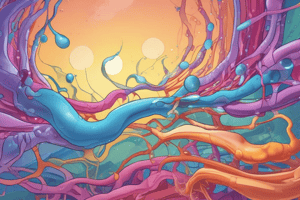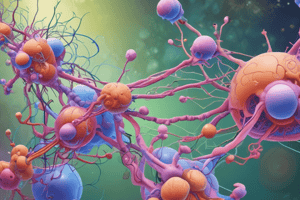Podcast
Questions and Answers
What is the structure of G protein-coupled receptors?
What is the structure of G protein-coupled receptors?
7 transmembrane domains
Which type of G protein is responsible for activating adenylate cyclase?
Which type of G protein is responsible for activating adenylate cyclase?
- Gas (correct)
- G protein kinase
- Gaq
- Gai
G protein-coupled receptors are the largest single class of targets for therapeutic drugs.
G protein-coupled receptors are the largest single class of targets for therapeutic drugs.
True (A)
G proteins link GPCRs to effector proteins that generate intracellular ________ messengers.
G proteins link GPCRs to effector proteins that generate intracellular ________ messengers.
Match the G protein with its function: Gas, Gai, Gaq
Match the G protein with its function: Gas, Gai, Gaq
What is the main function of adenylate cyclase in the signal transduction pathway?
What is the main function of adenylate cyclase in the signal transduction pathway?
Which molecule catalyzes the exchange of GDP for GTP in the activation of G protein?
Which molecule catalyzes the exchange of GDP for GTP in the activation of G protein?
GTP hydrolysis leads to the formation of GDP in the inactivation of G protein.
GTP hydrolysis leads to the formation of GDP in the inactivation of G protein.
In the return to the resting state, the _____ dissociates from the G protein.
In the return to the resting state, the _____ dissociates from the G protein.
What is the primary characteristic of G-protein receptors?
What is the primary characteristic of G-protein receptors?
Why are G-protein receptors called 'metabotropic' receptors?
Why are G-protein receptors called 'metabotropic' receptors?
G-protein coupled receptors have 7 helical transmembrane domains.
G-protein coupled receptors have 7 helical transmembrane domains.
G-protein coupled receptors can be linked to ______ channels, can generate second messengers, and can cause protein phosphorylation.
G-protein coupled receptors can be linked to ______ channels, can generate second messengers, and can cause protein phosphorylation.
Match the following neurotransmitters with their respective receptor types:
Match the following neurotransmitters with their respective receptor types:
What type of receptors do hormones or slow neurotransmitters bind to?
What type of receptors do hormones or slow neurotransmitters bind to?
Salbutamol is an alpha1 adrenoceptor agonist.
Salbutamol is an alpha1 adrenoceptor agonist.
What is the effect of activating beta adrenoceptors?
What is the effect of activating beta adrenoceptors?
Acetylcholine is a _______________________ agonist.
Acetylcholine is a _______________________ agonist.
Match the following G protein-coupled receptors with their respective agonists:
Match the following G protein-coupled receptors with their respective agonists:
What is the effect of alpha2 adrenoceptors?
What is the effect of alpha2 adrenoceptors?
G protein-coupled receptors respond to fast acting neurotransmitters.
G protein-coupled receptors respond to fast acting neurotransmitters.
What is the effect of activating alpha1 adrenoceptors?
What is the effect of activating alpha1 adrenoceptors?
The three main classes of Galpha proteins are Gas, Gaq, and _______________________.
The three main classes of Galpha proteins are Gas, Gaq, and _______________________.
What is the effect of activating G protein-coupled receptors?
What is the effect of activating G protein-coupled receptors?
What happens when Gas activates adenylate cyclase?
What happens when Gas activates adenylate cyclase?
Protein phosphatases cause protein activation.
Protein phosphatases cause protein activation.
What is the role of protein kinases in protein regulation?
What is the role of protein kinases in protein regulation?
G protein receptors are also known as ______________ receptors.
G protein receptors are also known as ______________ receptors.
What is the function of the alpha subunit in G protein signaling?
What is the function of the alpha subunit in G protein signaling?
Gaq activates adenylate cyclase.
Gaq activates adenylate cyclase.
What is the role of effector proteins in G protein signaling?
What is the role of effector proteins in G protein signaling?
Binding of a first messenger generates a ______________ messenger.
Binding of a first messenger generates a ______________ messenger.
Match the G protein with its function:
Match the G protein with its function:
What is the outcome of the G protein signal transduction pathway?
What is the outcome of the G protein signal transduction pathway?
What is the characteristic of G-protein receptors that makes them 'metabotropic'?
What is the characteristic of G-protein receptors that makes them 'metabotropic'?
G-protein coupled receptors can be linked to ion channels.
G-protein coupled receptors can be linked to ion channels.
What is the largest superfamily of receptors?
What is the largest superfamily of receptors?
G-protein coupled receptors are characterized by having ______________ transmembrane domains.
G-protein coupled receptors are characterized by having ______________ transmembrane domains.
What is a characteristic of receptor superfamilies?
What is a characteristic of receptor superfamilies?
Superfamilies are distinguished by what stimulates the receptor.
Superfamilies are distinguished by what stimulates the receptor.
What type of compounds are endogenous to G protein receptors?
What type of compounds are endogenous to G protein receptors?
G protein receptors interact with ______________ proteins.
G protein receptors interact with ______________ proteins.
How many major types of receptors are there?
How many major types of receptors are there?
Match the following compounds with their respective receptor types:
Match the following compounds with their respective receptor types:
What happens when an agonist binds to a receptor?
What happens when an agonist binds to a receptor?
G protein activation leads to the hydrolysis of GTP to GDP.
G protein activation leads to the hydrolysis of GTP to GDP.
What is the result of smooth muscle relaxation?
What is the result of smooth muscle relaxation?
Ga protein binds to _______ cyclase.
Ga protein binds to _______ cyclase.
What is the result of GTP binding to Ga?
What is the result of GTP binding to Ga?
Smooth muscle contraction is caused by the activation of beta2-adrenoreceptors.
Smooth muscle contraction is caused by the activation of beta2-adrenoreceptors.
What happens to the receptor after agonist binding?
What happens to the receptor after agonist binding?
The binding of an agonist to a receptor causes a conformational change, increasing the affinity of the _______ protein.
The binding of an agonist to a receptor causes a conformational change, increasing the affinity of the _______ protein.
Match the following receptors with their respective effects on smooth muscle:
Match the following receptors with their respective effects on smooth muscle:
Ga protein dissociates from adenylate cyclase after GTP is hydrolyzed to GDP.
Ga protein dissociates from adenylate cyclase after GTP is hydrolyzed to GDP.
Flashcards are hidden until you start studying
Study Notes
G Protein-Coupled Receptors
- Largest superfamily of receptors, with the largest single class of targets for therapeutic drugs
- These GTP- and GDP-binding proteins, comprising three subunits α, β, and γ, play a crucial role in mediating the signal transduction pathways initiated by G protein-coupled receptors.
- Activate signal transduction pathways, such as adenylate cyclase, phospholipase C, phosphodiesterase, and ion channels
- Respond to various ligands, including hormones, neurotransmitters, opioids, amines, peptides, proteins, light-sensitive compounds, and odors
Structure of GPCR
- 7 transmembrane domain receptors, also called metabotropic receptors or heptahelical receptors
- Ligand binding sites are located on the extracellular surface
- Heterotrimeric G protein binds to the intracellular surface
Examples of GPCRs
- Adrenoceptors, muscarinic acetylcholine receptors, serotonin receptors, dopamine receptors, and many others
- Salbutamol, a β2-adrenoceptor agonist, relieves bronchospasm in asthma
Physiological Roles of GPCRs
- Autonomic nervous system: muscarinic acetylcholine receptors activate phospholipase C, while β-adrenoceptors activate adenylate cyclase
- Vision: light activates rhodopsin, a GPCR
- Smell: odorant molecules activate GPCRs, which stimulate adenylate cyclase
- Behaviour and mood: various neurotransmitters and neuropeptides interact with GPCRs to modulate mood and behaviour
G Protein Signalling
- Comprise 3 subunits: α, β, and γ
- α-subunit binds GTP and has GTPase activity
- 3 main classes of Gα proteins: Gαs, Gαi, and Gαq
- Gαs activates adenylate cyclase, while Gαi inhibits adenylate cyclase, and Gαq activates phospholipase C
Adenylate Cyclase Signal Transduction Pathway
- Ligand binds to receptor, activating G protein
- G protein activates adenylate cyclase, which converts ATP to cAMP
- cAMP activates protein kinase A, leading to a response
Phospholipase C Signal Transduction Pathway
- Ligand binds to receptor, activating G protein
- G protein activates phospholipase C, which breaks down phosphatidylinositol 4,5-bisphosphate into inositol 1,4,5-trisphosphate and diacylglycerol
- Inositol 1,4,5-trisphosphate releases Ca2+, while diacylglycerol activates protein kinase C, leading to a response
G-Protein Receptors
- Metabotropic receptors are associated with one or more metabolic steps.
- G-protein receptors are called metabotropic because they involve the action of 1 or more metabolic pathways.
Structure of G-Protein Coupled Receptors
- G-protein coupled receptors have 7 helical transmembrane domains, making them "hepta helical".
- They can be linked to ion channels, generate second messengers, or cause protein phosphorylation.
Receptor Superfamily
- Receptor superfamily consists of 4 major types of receptors with similar transduction processes and general structures.
- Superfamilies are distinguished by how the signal is transduced, not by what stimulates the receptor or how the stimulation changes cell function.
G-Protein Coupled Receptors
- G-protein coupled receptors are the largest superfamily.
- They can respond to endogenous compounds such as neurotransmitters, hormones, opioids, amines, peptides, proteins, light-sensitive compounds, and odours.
Signal Transduction Pathways
- Signal transduction pathways linked to G-protein receptors include adenylate cyclase, phospholipase C, phosphodiesterase, and ion channels.
How G-Protein Coupled Receptors Work
- Drug binds to G-protein receptor, leading to a change in cell function via intracellular G-protein.
Binding Sites of G-Protein Receptors
- G-protein receptors have two binding sites: in the membrane (N-terminus) or extracellular (C-terminus).
Enzymes or Channels
- Enzymes or channels are effectors of G-protein coupled receptors.
Hormones and Neurotransmitters
- G-protein coupled receptors respond to slow-acting hormones or neurotransmitters (seconds).
Examples of G-Protein Coupled Receptors
- Adrenoceptors, muscarinic aCh receptors, and beta-2 adrenoceptor agonist salbutamol (relieves bronchospasm in asthma) are examples of G-protein coupled receptors.
G-Protein Proteins
- Three main classes of G-alpha proteins are Gas, Gaq, and Gai, which activate adenylate cyclase, inhibit adenylate cyclase, and activate phospholipase C, respectively.
Protein Kinases and Phosphatases
- Protein kinases and phosphatases are responsible for protein regulation, with kinases phosphorylating proteins (add P group) for activation, and phosphatases dephosphorylating proteins (remove P group) for deactivation.
G-Protein Signal Transduction Pathway
- Agonist binds to receptor, activating G-protein, which activates effector, generating a second messenger, activating protein kinase, and causing a response through a cascade response.
Activation of G-Protein
- Agonist binds to receptor, causing a conformational change, increasing affinity of G-protein, and activating it.
Activation of Adenylate Cyclase
- Ga dissociates from other G-proteins, binds to adenylate cyclase, converts ATP to cAMP, hydrolyses GTP to GDP, dissociates from adenylate cyclase, returns to G-proteins, and receptor dissociates from G-proteins.
G-Protein Receptors
- Metabotropic receptors are associated with one or more metabolic steps.
- G-protein receptors are called metabotropic because they involve the action of 1 or more metabolic pathways.
Structure of G-Protein Coupled Receptors
- G-protein coupled receptors have 7 helical transmembrane domains, making them "hepta helical".
- They can be linked to ion channels, generate second messengers, or cause protein phosphorylation.
Receptor Superfamily
- Receptor superfamily consists of 4 major types of receptors with similar transduction processes and general structures.
- Superfamilies are distinguished by how the signal is transduced, not by what stimulates the receptor or how the stimulation changes cell function.
G-Protein Coupled Receptors
- G-protein coupled receptors are the largest superfamily.
- They can respond to endogenous compounds such as neurotransmitters, hormones, opioids, amines, peptides, proteins, light-sensitive compounds, and odours.
Signal Transduction Pathways
- Signal transduction pathways linked to G-protein receptors include adenylate cyclase, phospholipase C, phosphodiesterase, and ion channels.
How G-Protein Coupled Receptors Work
- Drug binds to G-protein receptor, leading to a change in cell function via intracellular G-protein.
Binding Sites of G-Protein Receptors
- G-protein receptors have two binding sites: in the membrane (N-terminus) or extracellular (C-terminus).
Enzymes or Channels
- Enzymes or channels are effectors of G-protein coupled receptors.
Hormones and Neurotransmitters
- G-protein coupled receptors respond to slow-acting hormones or neurotransmitters (seconds).
Examples of G-Protein Coupled Receptors
- Adrenoceptors, muscarinic aCh receptors, and beta-2 adrenoceptor agonist salbutamol (relieves bronchospasm in asthma) are examples of G-protein coupled receptors.
G-Protein Proteins
- Three main classes of G-alpha proteins are Gas, Gaq, and Gai, which activate adenylate cyclase, inhibit adenylate cyclase, and activate phospholipase C, respectively.
Protein Kinases and Phosphatases
- Protein kinases and phosphatases are responsible for protein regulation, with kinases phosphorylating proteins (add P group) for activation, and phosphatases dephosphorylating proteins (remove P group) for deactivation.
G-Protein Signal Transduction Pathway
- Agonist binds to receptor, activating G-protein, which activates effector, generating a second messenger, activating protein kinase, and causing a response through a cascade response.
Activation of G-Protein
- Agonist binds to receptor, causing a conformational change, increasing affinity of G-protein, and activating it.
Activation of Adenylate Cyclase
- Ga dissociates from other G-proteins, binds to adenylate cyclase, converts ATP to cAMP, hydrolyses GTP to GDP, dissociates from adenylate cyclase, returns to G-proteins, and receptor dissociates from G-proteins.
Studying That Suits You
Use AI to generate personalized quizzes and flashcards to suit your learning preferences.




